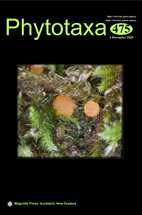Abstract
Bocagea, a distinctive genus of tribe Bocageeae (Annonaceae), is revisited here. It is endemic to the Brazilian Atlantic Forest and has been for almost 200 years represented by only two species, B. longepedunculata and B. viridis. Recent collections from Espírito Santo and São Paulo States produced two new species, described here. The species of Bocagea are rare plants, all of them classified at least as endangered.
References
<p class="Reference">Almeida, V.E. (2012) A muralha e a representação indígena na televisão, na literatura e nas ciências sociais. <em>PROA Revista de Antropologia e Arte</em> 4: 194–209.</p><p class="Reference">Assis, L.C.S. & Brigandt, I. (2009) Homology: homeostatic property cluster kinds in systematics and evolution. <em>Evolutionary Biology</em> 36: 248–255.</p><p class="Reference"> <a href="https://doi.org/10.1007/s11692-009-9054-y">https://doi.org/10.1007/s11692-009-9054-y</a></p><p class="Reference">Bachman, S., Moat, J., Hill, A.W., Torre, J. & Scott, B. (2011) Supporting Red List threat assessments with GeoCAT: geospatial conservation assessment tool. <em>ZooKeys</em> 150: 117–126.</p><p class="Reference"> <a href="https://doi.org/10.3897/zookeys.150.2109">https://doi.org/10.3897/zookeys.150.2109</a></p><p class="Reference">Chatrou, L.W., Pirie, M.D., Erkens, R.H.J., Couvreur, T.L.P., Neubig, K.M.J., Abbott, R., Mols, J.B., Maas, J.W., Saunders, R.M.K. & Chase, M.W. (2012) A new subfamilial and tribal classification of the pantropical flowering plant family Annonaceae informed by molecular phylogenetics. <em>Botanical Journal of the Linnean Society</em> 169: 5–40.</p><p class="Reference"> <a href="https://doi.org/10.1111/j.1095-8339.2012.01242.x">https://doi.org/10.1111/j.1095-8339.2012.01242.x</a></p><p class="Reference">Dalzell, N.A. (1851) Contributions to the botany of western India. <em>Hooker’s Journal of Botany and Kew Garden Miscellany</em> 3: 206–212.</p><p class="Reference">Dean, W. (1995) <em>With broadax and firebrand. The destruction of the Brazilian Atlantic Forest</em>. University of California Press, Berkeley, 482 pp.</p><p class="Reference">Fries, R.E. (1931) Revision der Arten einiger Anonaceen-Gattungen II. <em>Acta Horti Bergiani</em> 10: 129–341, taf. 1–27.</p><p class="Reference">Hickey, L.J. (1979) A revised classification on the architecture of dicotyledonous leaves. <em>In</em>: Metcalfe, C.R. & Chalk, L. (Eds.) <em>Anatomy of the dicotyledons</em>, ed. 2., vol. 1. Clarendon, Oxford, pp. 25–39.</p><p class="Reference">Houaiss, A. & Villar, M.S. (2007) <em>Dicionário Houaiss da língua portuguesa</em>, second edition. Editora Objetiva, Rio de Janeiro, 2922 pp.</p><p class="Reference">IPNI (2020) <em>International plant names index</em>. The Royal Botanic Gardens, Kew, Harvard University Herbaria & Libraries and Australian National Botanic Gardens. Published on the Internet. Available from: <a href="http://www.ipni.org">http://www.ipni.org</a> (Retrieved 5 June 2020)</p><p class="Reference">IUCN (2012) <em>IUCN Red List Categories and Criteria</em>, version 3.1, second edition. IUCN Species Survival Commission, Gland, 32 pp.</p><p class="Reference">Johnson, D.M. & Murray, N.A. (1995) Synopsis of the tribe Bocageeae (Annonaceae), with revisions of <em>Cardiopetalum</em>, <em>Froesiodendron</em>, <em>Trigynaea</em>, <em>Bocagea</em>, and <em>Hornschuchia</em>. <em>Brittonia</em> 47: 248–319.</p><p class="Reference"> <a href="https://doi.org/10.2307/2807118">https://doi.org/10.2307/2807118</a></p><p class="Reference">JStor Global Plants (2020) <em>Global database of digitized plant specimens</em>. Available from: <a href="https://plants.jstor.org">https://plants.jstor.org</a> (accessed 12 July 2020)</p><p class="Reference">Martius, C.F.P. (1841) Annonaceae. <em>In</em>: Martius, C.F.P & Eichler, A.W. (Eds.) <em>Flora brasiliensis</em>, vol. 13(1). Wolf, Munich, pp. 1–64, tab.1–14.</p><p class="Reference">Morawetz, W., Svoma, E. & Benko-Iseppon, A. (1993) An unusual Annonaceae from SE Brazil. <em>Annonaceae Newsletter</em> 9: 62–64.</p><p class="Reference">Myers, N., Mittermeier, R.A., Mittermeier, C.G., Fonseca, G.A.B. & Kent, J. (2000) Biodiversity hotspots for conservation priorities. <em>Nature</em> 402: 853–858.</p><p class="Reference"> <a href="https://doi.org/10.1038/35002501">https://doi.org/10.1038/35002501</a></p><p class="Reference">Mello-Silva, R. (2018) Land of the giants. Remarkable botanical findings highlight a new area for conservation in Brazil. <em>Rodriguésia</em> 69: 933–937.</p><p class="Reference"> <a href="https://doi.org/10.1590/2175-7860201869245">https://doi.org/10.1590/2175-7860201869245</a></p><p class="Reference">Nazareno, A.G. & Vitule, J.R.S. (2016) Too many mining disasters in Brazil. <em>Nature</em> 531: 580.</p><p class="Reference"> <a href="https://doi.org/10.1038/531580e">https://doi.org/10.1038/531580e</a></p><p class="Reference">Nees von Esenbeck, C.G.D. (1821) Reise des Prinzen von Neuwied. <em>Flora</em> 4: 294–304.</p><p class="Reference">Paula, L.F.A., Azevedo, L.O., Mauad, L.P., Cardoso, L.J.T., Braga, J.M.A., Kollmann, L.J.C., Fraga, C.N., Menini Neto, L., Labiak, P.H., Mello-Silva, R., Porembski, S. & Forzza, R.C. (2020) Sugarloaf Land in southeastern Brazil: a tropical hotspot of lowland inselberg plant diversity. <em>Biodiversity Data Journal</em> 8: e53135, 1–26.</p><p class="Reference"> <a href="https://doi.org/10.3897/BDJ.8.e53135">https://doi.org/10.3897/BDJ.8.e53135</a></p><p class="Reference">Queiroz, D.S. (1954) <em>A Muralha</em>. José Olympio Editora, Rio de Janeiro, 459 pp.</p><p class="Reference">REFLORA (2020) <em>Plantas do Brasil: resgate histórico e herbário virtual para o conhecimento e conservação da flora brasileira.</em> Available from: <a href="http://floradobrasil.jbrj.gov.br/reflora">http://floradobrasil.jbrj.gov.br/reflora</a> (Accessed 12 July 2020)</p><p class="Reference">Rieppel, O. (2007) Species: kinds of individuals or individuals of a kind.<em> Cladistics</em> 23: 373–384.</p><p class="Reference"> <a href="https://doi.org/10.1111/j.1096-0031.2007.00152.x">https://doi.org/10.1111/j.1096-0031.2007.00152.x</a></p><p class="Reference">Saint-Hilaire, A.F.C.P. (1825) Annonaceae. <em>Flora Brasiliae meridionalis</em>, vol. 1. Belin, Paris, pp. 28–43.</p><p class="Reference">Saint-Hilaire, A.F.C.P. (1830) <em>Voyage dans les provinces de Rio de Janeiro et de Minas Geraes</em>, vol. 1. Grimbert et Dorez, Paris, 458 pp.</p><p class="Reference">Schlechtendal, D.F.L. (1834) De Anonaceis brasiliensibus herbarii regii berolinensis. <em>Linnaea</em> 9: 315–331.</p><p class="Reference">Thiers, B. (2020, continuously updated) <em>Index herbariorum: a global directory of public herbaria and associated staff</em>. New York Botanical Garden’s Virtual Herbarium. Available from: <a href="http://sweetgum.nybg.org/ih/">http://sweetgum.nybg.org/ih/</a> (accessed 12 July 2020)</p><p class="Reference">Wied-Neuwied, M.A.P. (1820) <em>Reise nach Brasilien in den Jahren 1815 bis 1817</em>, vol. 1. Brönner, Frankfurt am Main, 376 pp.</p><p> <a href="https://doi.org/10.5962/bhl.title.85967">https://doi.org/10.5962/bhl.title.85967</a></p>

